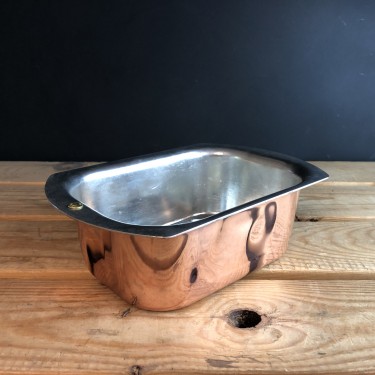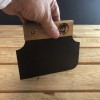Shropshire made tin lined copper loaf tin
- Product Code: NFS-303
- Availability: In Stock
-
£192.30
- Ex Tax: £160.25
Accessories
Copper 1lb (0.5 kg) tin lined, loaf tin
Shropshire made tin lined solid copper loaf tin.
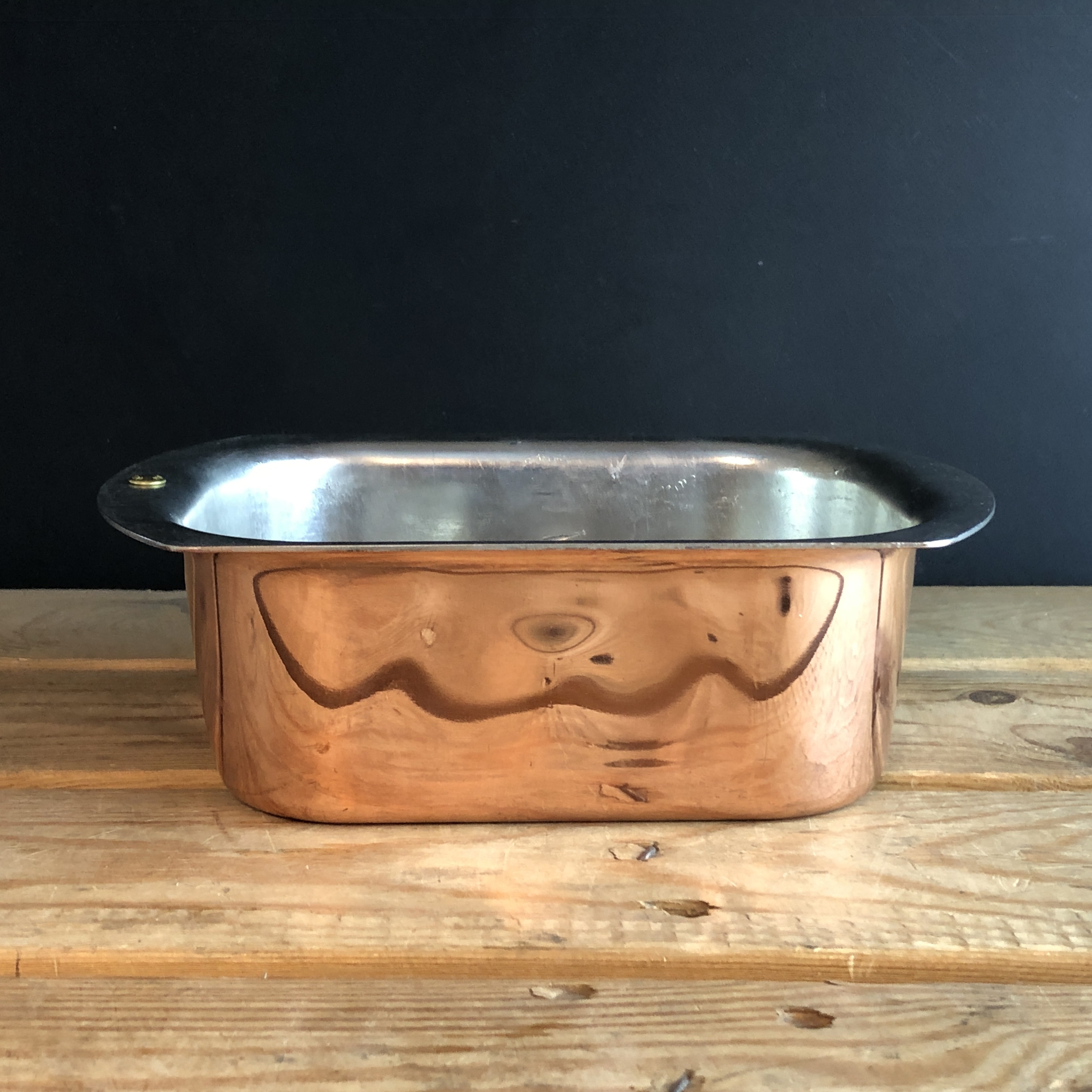
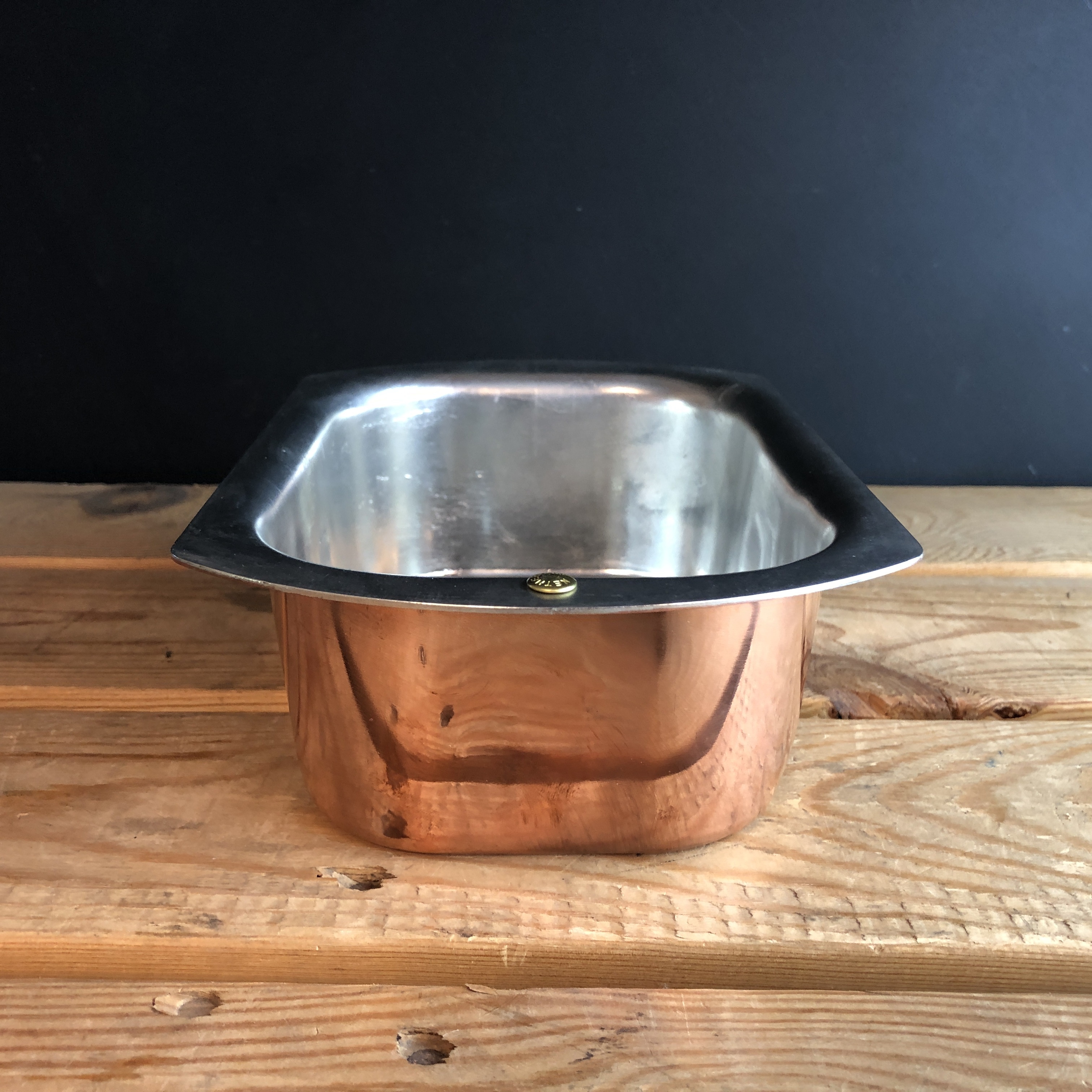
A solid 1.5mm, heavy duty, copper loaf tin is polished to a soft lustre and features the Netherton logo stamped on the base.
The hand wiped tin lining in this loaf tin is food grade approved pure metal and is the classic method of protecting the copper from acidic foods and thus preventing flavour tainting.
This tin is PLASTIC, PTFE & PFOA free.
Perfect for breads and cakes, patés and terrines.
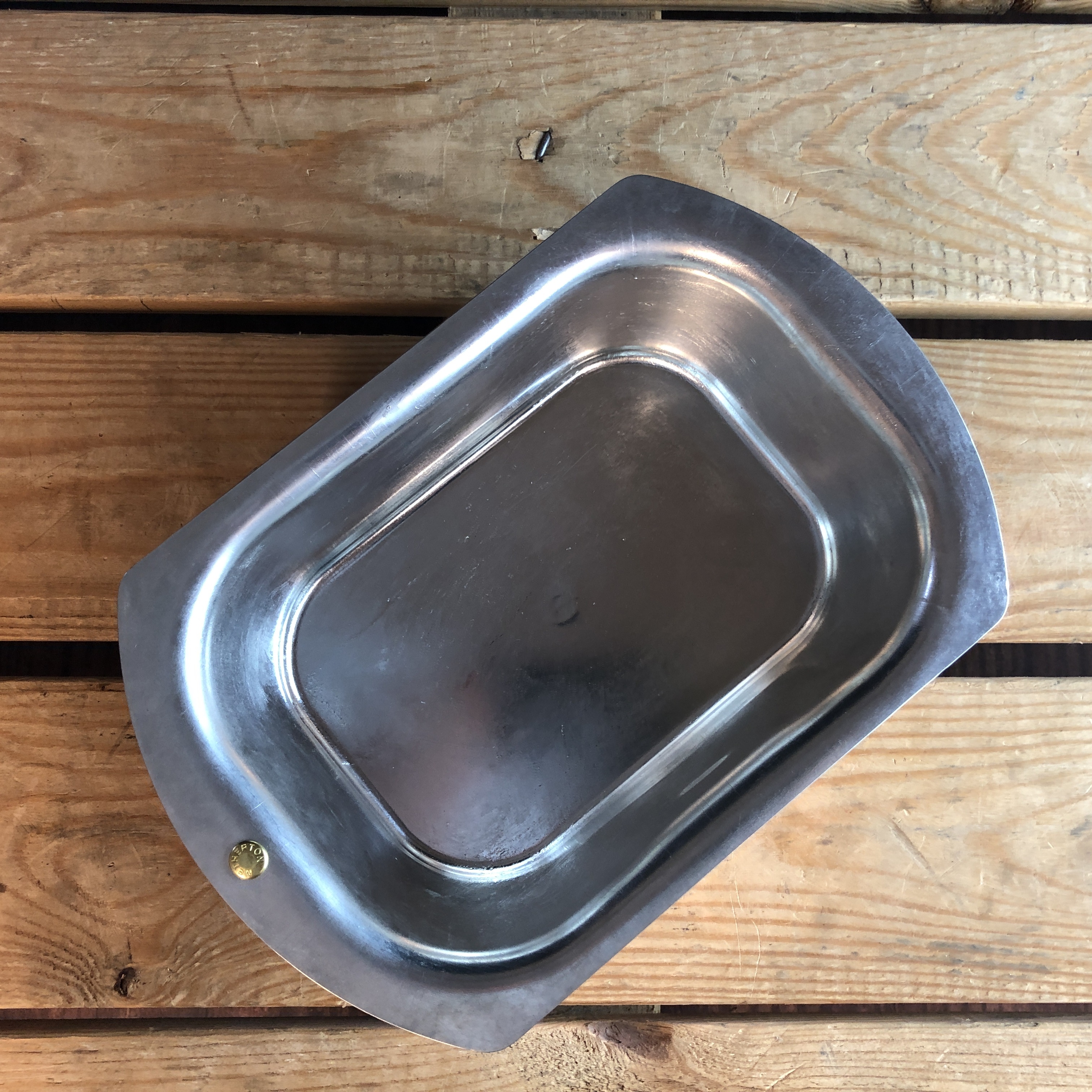
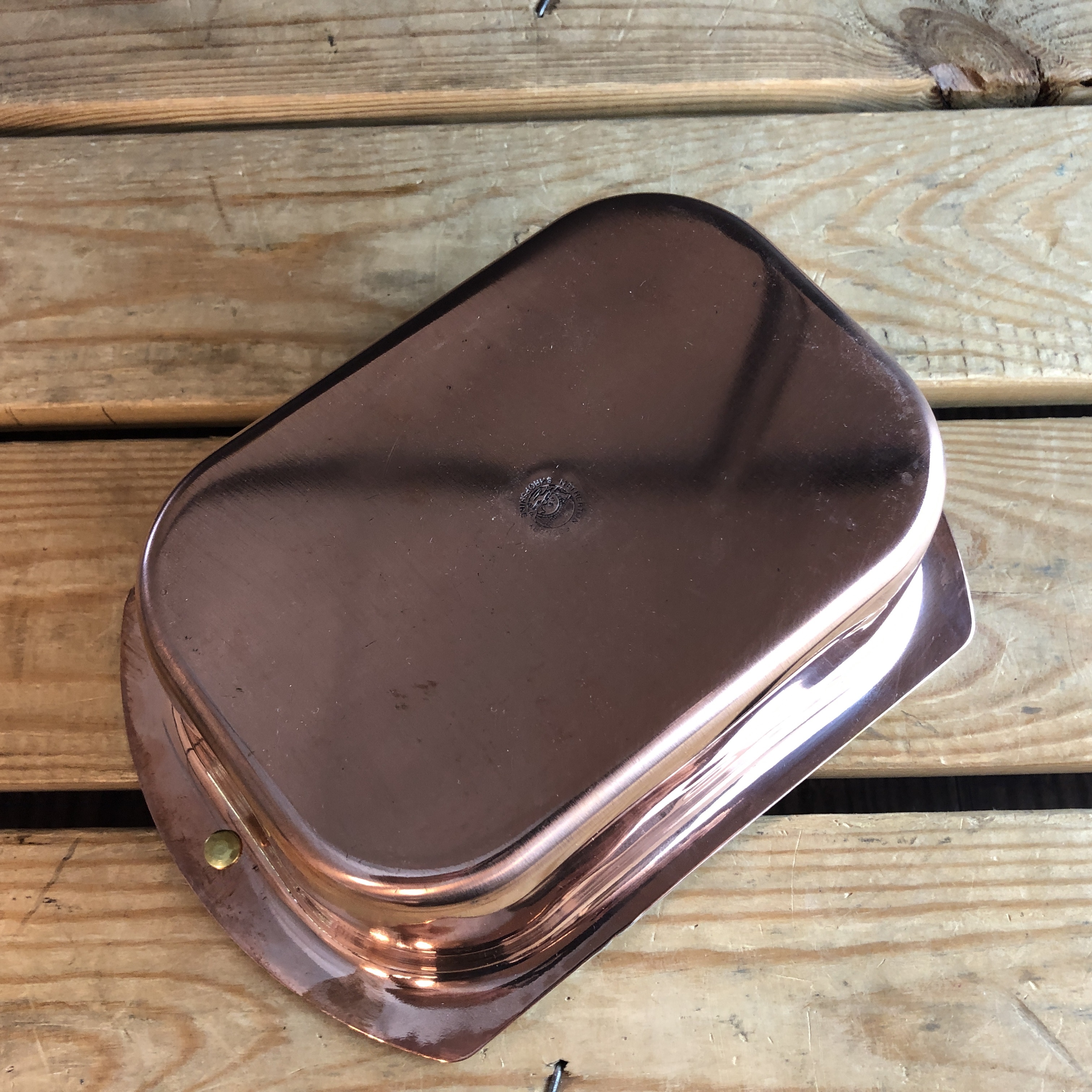
Do not clean in dish washer.
Copper is a soft material, it will scratch if dragged across a rough or unclean surface. Always wipe with clean cloths or sponges.
Over heating to more than 235ºC with melt the tin lining and will distort the tin. Don't drop a hot tin into cold water.
An attractive alternative to our iron loaf tins.
If you are new to tin lined copper cookware we recommend that you read all of this page before buying.
Every tin is handmade, no two are the same.
Dimensions:
Weight 1lb 11oz (779g),
Tin dimensions: 8½'' (22cm) long x 5½" (14.5cm) wide x 2¾" (7.2cm) high.
Loaf dimensions: 6¾'' (17cm) long x 4½" (12.0cm) wide x 2¾" (7.2cm) high.
Why are tin lined copper tins so good?
It's simply physics; copper is the most conductive engineering metal available. It's twice as conductive as aluminium and an amazing 25 times more conductive than stainless steel. Possibly its only rival is pure silver, which is 5% more conductive than copper and 100 times more expensive. Our tin lining is a magical material; it is very non stick and it protects the copper from acidic food and corrosion. Tin doesn't taint food or hold strong flavours and is easily washed by hand.
Advantages of our tin lined copper tins.
Copper is very intuitive to use, it responds quickly to changes in power.
Heat distributes very evenly across the base and up the sides.
There is no taint from metals or coatings.
Users don't need to be concerned about the risks from chemical non-stick coatings.
The tin lining has exceptionally good non stick properties and is easy to hand wash.
Disadvantages of copper cookware.
Tin melts at 232ºC (450ºF). A tin placed in an overheated oven may melt the lining that will then need retinning.
The tin lining will wear out rapidly if you use metal spoons and utensils, we recommend only using wood or silicon tools.
Not all copper cookware is created equal.
Most copper pots and pans sold today are in fact laminates of copper and stainless steel or even copper, aluminium and stainless steel. This does make them cheaper to buy, but does miss the principal advantage of copper. Even a thin layer of stainless steel significantly reduces the superb performance. The tin lining is simply one of the best non-stick surfaces available. In comparison, stainless steel is certainly not renowned for is non-stick qualities . So why do the famous brands choose to pass these laminates off as real copper? Simply because it's much cheaper to make and so can be sold at lower prices. This is fine if you are happy with the aesthetics and are prepared to compromise performance for a lower price. These are not real traditional copper pots and pans. If performance is your goal, you don't want stainless steel, you need a tin lining.
Restoring and retinning old and new pots and pans.
As new tin lined copper pans have been widely unavailable for more than 25 years, a substantial trade has developed in finding, restoring and retinning vintage pans, especially in France and the USA. We applaud this sensible reuse of materials. Inevitably the supply of quality restorable pans in sensible sets and sizes is limited and now dwindling. That's why Netherton Foundry has been encouraged by our food loving supporters once again to make new tin lined copper pans in the traditional way. If you have an old copper pan or eventually need to re-tin a Netherton pan we strongly recommend that you contact our experts: Thomas Gamesons and Sons, Stafforshire, England, They've been tin lining pans since 1818. or House Copper and Cookware, Wisconsin, USA.
Looking after the solid copper loaf tin.
Cleaning: After use, wipe the inside and outside of the copper saucepan with soapy water and rinse thoroughly
Don’t use an aggressive scourer or you will rapidly wear through the lining and it will require re-tinning.
Temperature: Do not leave your empty tin in the oven for too long or the lining may melt (232º C / 450ºF), and it will require relining.
At home the tin lining should last for years depending on care and frequency of use. As a result we cannot guarantee the life of the lining against harsh or heavy usage
The biggest causes of rapid wear are metal spoons and whisks, so please use a wooden or silicon spoon and silicon whisk.
History of tin lined cookware.
The practice of tinning ironware to protect it against rust is an ancient one. This may have been the work of the whitesmith. This was done after the article was fabricated.
The first production of tinplate was probably in Bohemia, from where the trade spread to Saxony, and was well-established there by the 1660s when Andrew Yarranton and Ambrose Crowle, a Stourbridge blacksmith (not far from Highley, the home of Netherton) visited Dresden to find out how it was made. In Saxony the plates were forged, but when they conducted experiments on their return to England, they tried rolling the iron. This led to the ironmasters Philip Foley and Joshua Newborough erecting a new mill in 1670 in Wolverley . By 1678 they were making frying pans
Today our food grade tin is applied to a cleaned and fluxed coated pan by hand by skilled craftsmen.
INSTRUCTION BOOKLET: Caring for Netherton Foundry copper pots and pans
Cleaning and care.
After use, leave your tin to soak in soapy water to loosen any stuck on food. Use a non-abrasive sponge or cloth and warm, soapy water to clean your tin. Rinse and dry thoroughly. Do not use an aggressive scourer, or you will rapidly wear through the lining. Never put copper cookware in the dishwasher.
Netherton Foundry copper cookware is lined with tin. These linings may discolour over time. This isn’t a problem. Your copper tin may need to be re-tinned at some point over its lifetime. This is only needed if you start to see copper showing through the lining.
Over time a greenish patina may develop on a copper surface. This is perfectly fine on your tin if it is not going to touch the food. If you want to remove this, the tin can be polished using a copper cleaner and a soft cloth, then rinsed with water and dried thoroughly. This should keep the copper looking shiny.
Temperature
If you place your pan in an oven, it is best not to go above 180ºC / 356ºF.
Wear & re-tinning
The tin lining is not covered by the warranty as we cannot predict wear and use. The biggest causes of rapid wear are metal spoons and whisks, so please only use wooden or silicon utensils.
If you wear through or damage the tin-lining you can get this restored by these experts.:
UK and Europe: Thomas Gameson and Sons Ltd, Staffordshire, England, they’ve been doing this for 200 years, Find out more and contact them here.
USA and Canada: Sara Dahmen at House Copper and Cookware, Wisconsin, USA : Find out more and contact her here.
We reserve the right to amend specification as part of our policy of continual product improvements. All sizes, weights, dimensions, temperatures, times, consumption figures are approximate only. Your new product has a warranty of 24 months from the date of consumer purchase. Please keep your receipt or order number as it will be required as proof of date of purchase. This warranty only applies if the item has been used solely for household use in the UK, and all instructions have been followed properly. Abuse of your product will invalidate the warranty. Returned goods cannot be accepted unless repacked properly within the original packaging and presented with the original receipt. This does not affect your statutory rights. In the event of service query, please contact us on 01746 862781 where we will be pleased to help (Monday to Thursday 9am - 4pm, Friday 9am – 1pm); or via email on sales@netherton-foundry.co.uk. You can see our full range of products, including accessories, spares and our latest recipes at: www.netherton-foundry.co.uk
A white loaf recipe from Marie Lester for the copper loaf tin.

Marie has very kindly shared with us her recipe for a traditional white tin loaf (with a syrupy twist) made using yeast.
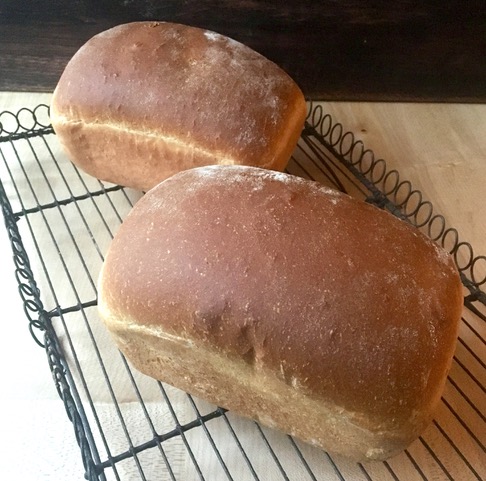
Ingredients for 2 x 1lb loaves:
Step 1
50 ml lukewarm (90-100°F / 32-38°C) water
15 g fresh yeast (or 7.5 g active dry yeast or 5 g instant dry yeast)
15 g fresh yeast (or 7.5 g active dry yeast or 5 g instant dry yeast)
Step 2
250 ml milk
60 g unsalted butter
50 ml maple syrup
1 egg (55g)
60 g unsalted butter
50 ml maple syrup
1 egg (55g)
Step 3
500 g strong white bread flour (I used 435 g Canadian Manitoba bread flour and 115g stoneground white wheat flour)
2 tsp salt (8g)
500 g strong white bread flour (I used 435 g Canadian Manitoba bread flour and 115g stoneground white wheat flour)
2 tsp salt (8g)
1-2 tsp light olive oil to coat the mixing bowl
Butter for greasing the loaf tins
Semolina for dusting thetop of the dough
Process:
In a small mixing bowl, crumble the fresh yeast into the water. Mix in 1 teaspoon of flour and 1 teaspoon of sugar (to feed it). Allow to stand until the mixture thickens and bubbles are visible on the surface.
If using active or instant dry yeast, follow the instructions on the packet.
Heat the milk, butter and maple syrup gently in a saucepan until the butter has melted. Pour into a small mixing bowl and allow to cool until it is lukewarm. (90-100ºF/32-38ºC)
Once it has reached lukewarm temperature, add the yeasty liquid and stir together. Then whisk in the egg.
Weigh the flours and salt into the bowl of a kitchen mixer and stir together. Attach the dough hook and turn on to a low setting (Kitchenaid 2). Slowly pour in the liquid and mix until a dough starts to form.. With the speed set at 2, mix for 8-10 minutes until the dough forms a ball and pulls away from the sides of the bowl. With wet fingers, try to gently stretch out a piece of dough into a panel. It should hold together without tearing easily.
Once it has reached lukewarm temperature, add the yeasty liquid and stir together. Then whisk in the egg.
Weigh the flours and salt into the bowl of a kitchen mixer and stir together. Attach the dough hook and turn on to a low setting (Kitchenaid 2). Slowly pour in the liquid and mix until a dough starts to form.. With the speed set at 2, mix for 8-10 minutes until the dough forms a ball and pulls away from the sides of the bowl. With wet fingers, try to gently stretch out a piece of dough into a panel. It should hold together without tearing easily.
TIP: Different flours absorb liquid differently. if the dough looks too wet or too dry, add a small amount of flour or liquid until the dough comes together.
Using your dough cutter turn the mixture onto a lightly -floured surface, and knead by hand for a couple of minues until the dough is smooth and elastic. Shape it into a ball, place in a large lightly oiled bowl and cover with a damp cloth. Leave to rise in a warm place for 1-2 hours, or until the dough has doubled in size.
Shaping the dough:
Turn the dough out ont a lightly floured surface. Divide into two pieces with your dough cutter. Shape each piece into a ball and rest for 15 minutes.
Taking each piece in turn, flatten the dough into a rectangle using the flat of your hand or a rolling pin. Fold the top corners of the dough over on itself and then roll into a log and seal the dough by pressing the dough edges together between your fingertips. Place into a greased 0.5kg/1lb loaf tin, positioning the seams at the bottom and tucking the ends underneath. Repeat with the second piece of dough.
Cover both tins with a slightly damp cloth and leave to rise for another 60-90 minutes until well-risen (the dough should reach the top of the tin). When they are risen, remove and finish the last part of the proofing on your kichen counter.
Meanwhile heat the oven to 170°C / 340°F/ Gas 3
NOTE: the copper tins conduct heat very well so you don't need the oven as hot as ordinary loaf tins..
Place a roasting dish on the bottom rack of the oven. Boil a kettle of water.
Place a roasting dish on the bottom rack of the oven. Boil a kettle of water.
Lightly dust the top of the dough with semolina or flour and score simply if you wish (this is optional)
Place the tins in the oven above the tray. Pour the freshly boiled water into the roasting tray. bake for 15-20 minutes then remove the tray of water. Bake the loaves for a further 15 minutes until they look golden brown on all sides and sound hollow ehen tapped underneath.
Turn the oven off , remove the loaves from their tins and place in the oven with the door ajar for 30 minues to cure. Remove and finish cooling on a wire rack for another 30 minutes.

Tags: Baking









